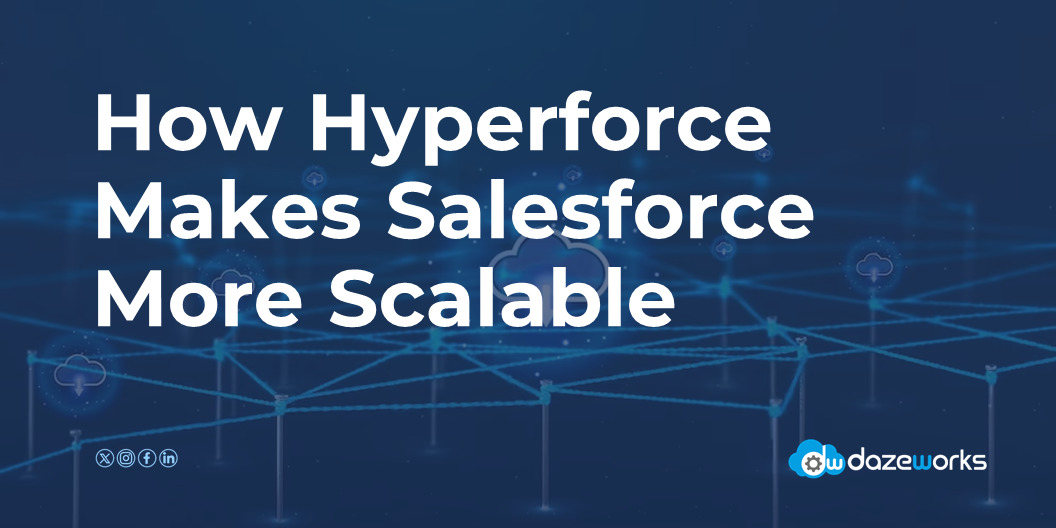
How Hyperforce Makes Salesforce More Scalable?
minutes read
Since its inception, Salesforce endeavors involved providing customers with the highest levels of security and performance. For over 20 decades, the cloud-giant has been storing data of its users in its own data centers. However, with the continuously growing data this process is beginning to prove inefficient. This is where the team researched and understood the potential of public cloud to facilitate the growth of their clients. Hence in 2020, Salesforce introduced Hyperforce, its public cloud architecture that allowed to touch new boundaries.
What is Salesforce Hyperforce?
Salesforce Hyperforce is an infrastructure architecture that amalgamates the foundation of clouds and enables Salesforce to scale securely and rapidly via public cloud platforms. It is designed to provide a more robust and scalable platform that facilitates users’ growth and success on a global scale. With Hyperforce, Salesforce does not manage any physical resources; and the only layer under it is platform, applications, functionalities, and clouds.
How Does Hyperforce Function?
Built on a microservices architecture, Hyperforce allows Salesforce to provide its services to various cloud providers. This means that different elements such as application servers, database, user interface, etc. can be hosted on various clouds without impacting the efficiency of any components.
Hypeforce is a composition of many technologies including Kubernetes, Apache Kafka and Istio that ensures seamlessness across different clouds. These technologies help Salesforce to manage the scaling, connectivity, and deployment, while ensuring high fault tolerance and availability.
Furthermore, Hyperforce also comes with robust security features that are dedicated to safeguarding customer data and regulate compliance with industry standards. Some of the key security features include access control, audit trails, and data encryption. Hyperforce also boasts compliance certifications such as ISO 27001 and SOC 2.
What are the Key Features of Hyperforce?
- Scalability: It is a crucial factor for emerging digital companies. Hyperforce allows you to incorporate various scalable features within its flexible infrastructure. You can easily deploy resources in public cloud and get full control over the process.
- Compliance: Businesses can store data locally while aligning with global compliance requirements. Hyperforce allows you to choose the location where you want the data to be stored. This further allows you the opportunity to comply with regulations centered to your company, industry, and region.
- Security: Salesforce is one of the most trusted and secure cloud-based software; hence with Hyperforce you can be rest assured about the security. Hyperforce allows you to protect confidential data with background-run functions to ascertain utmost privacy and security.
- Compatibility: Hyperforce is compatible with all existing Salesforce integrations, customizations, and applications. Moreover, you can future-proof all the apps with backward compatibility to avoid any disruptions.
What are the Benefits of Salesforce Hyperforce?
- Global Scalability: Hyperforce enables organizations to deploy Salesforce applications globally, providing the flexibility to scale resources based on business needs and geographical distribution.
- Data Residency and Compliance: It allows organizations to comply with data residency requirements by enabling data storage in specific regions or countries. This helps them adhere to local data protection and privacy regulations.
- Multi-Cloud Deployment: Hyperforce is designed to work on major public cloud platforms, providing organizations with the ability to choose the cloud provider that best suits their requirements or complies with their existing cloud strategy.
- Performance: By leveraging the capabilities of public cloud infrastructure, Hyperforce aims to provide improved performance and reduced latency for Salesforce applications, leading to a better user experience.
- Security: Hyperforce incorporates the security features of leading public cloud providers, enhancing the overall security posture of Salesforce applications. This includes encryption, identity management, and compliance with industry-standard security practices.
- Business Continuity: The distributed nature of Hyperforce is intended to provide improved resilience and business continuity. In the event of a regional or cloud provider-specific issue, organizations may experience less impact to their Salesforce services.
- Innovation: Salesforce Hyperforce is expected to enable organizations to take advantage of the latest innovations and features offered by public cloud providers, ensuring that they can leverage cutting-edge technologies as they become available.
- Flexibility and Agility: With Hyperforce, organizations can adapt their Salesforce deployments more easily to changing business requirements and IT strategies. It provides a level of flexibility that can be valuable for businesses with dynamic needs.
Conclusion
Salesforce Hyperforce represents a leap forward in cloud infrastructure, offering a comprehensive solution for organizations aiming to globalize their Salesforce deployments. As businesses navigate the complexities of the digital landscape, Hyperforce stands as a beacon of innovation, providing the tools needed to thrive in a borderless future. Embracing Hyperforce is not just an upgrade; it is a strategic move towards a more resilient, scalable, and secure cloud infrastructure that paves the way for continued success in the digital era.
